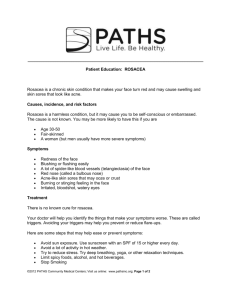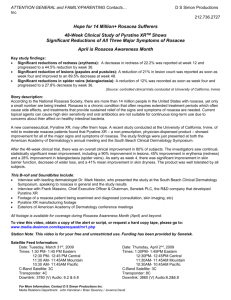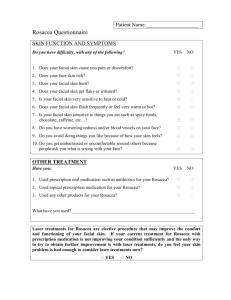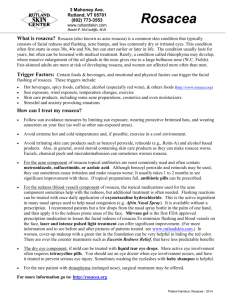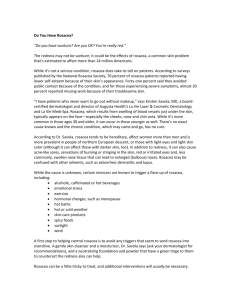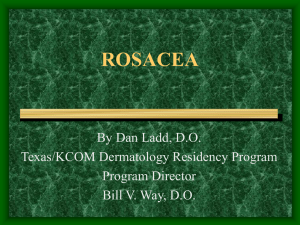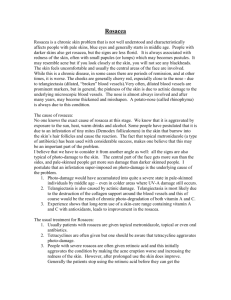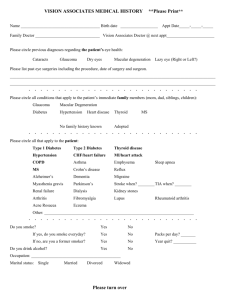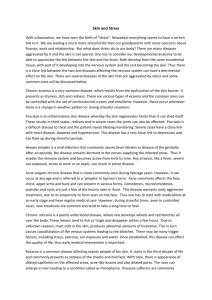The two faces of skin erythema: sensitive skin and rosacea
advertisement
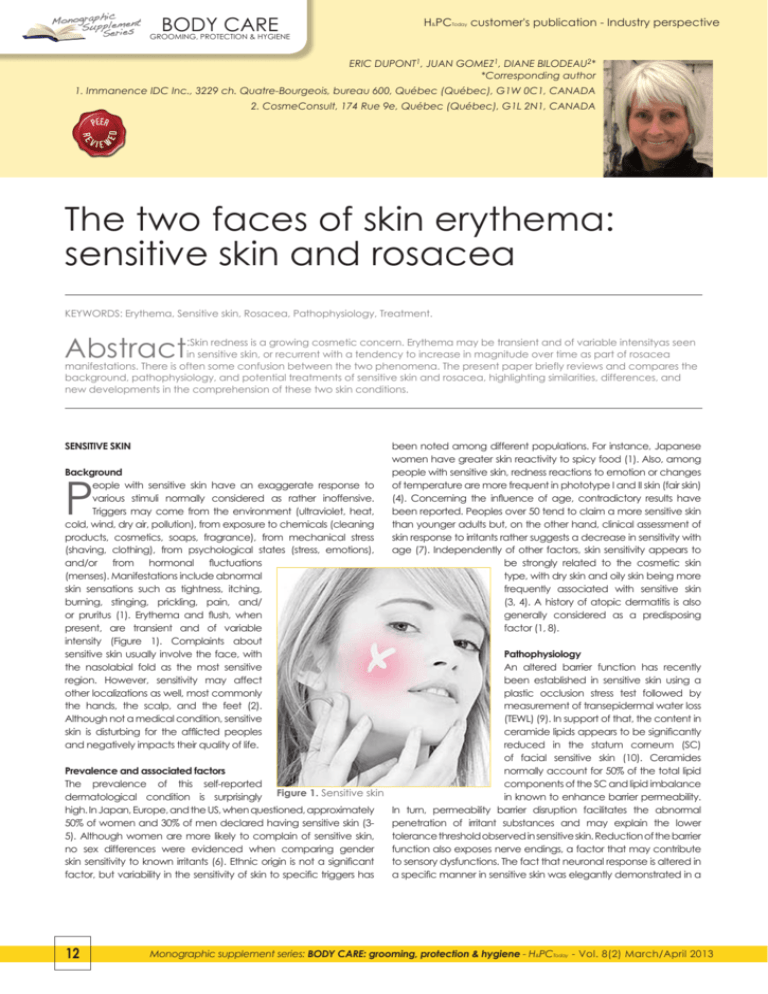
hic Monograp lement Supp Series GROOMING, PROTECTION & HYGIENE BODY CARE H&PCToday customer's publication - Industry perspective ERIC DUPONT1, JUAN GOMEZ1, DIANE BILODEAU2* *Corresponding author 1. Immanence IDC Inc., 3229 ch. Quatre-Bourgeois, bureau 600, Québec (Québec), G1W 0C1, CANADA 2. CosmeConsult, 174 Rue 9e, Québec (Québec), G1L 2N1, CANADA The two faces of skin erythema: sensitive skin and rosacea KEYWORDS: Erythema, Sensitive skin, Rosacea, Pathophysiology, Treatment. Abstract :Skin redness is a growing cosmetic concern. Erythema may be transient and of variable intensityas seen in sensitive skin, or recurrent with a tendency to increase in magnitude over time as part of rosacea manifestations. There is often some confusion between the two phenomena. The present paper briefly reviews and compares the background, pathophysiology, and potential treatments of sensitive skin and rosacea, highlighting similarities, differences, and new developments in the comprehension of these two skin conditions. SENSITIVE SKIN Background eople with sensitive skin have an exaggerate response to various stimuli normally considered as rather inoffensive. Triggers may come from the environment (ultraviolet, heat, cold, wind, dry air, pollution), from exposure to chemicals (cleaning products, cosmetics, soaps, fragrance), from mechanical stress (shaving, clothing), from psychological states (stress, emotions), and/or from hormonal fluctuations (menses). Manifestations include abnormal skin sensations such as tightness, itching, burning, stinging, prickling, pain, and/ or pruritus (1). Erythema and flush, when present, are transient and of variable intensity (Figure 1). Complaints about sensitive skin usually involve the face, with the nasolabial fold as the most sensitive region. However, sensitivity may affect other localizations as well, most commonly the hands, the scalp, and the feet (2). Although not a medical condition, sensitive skin is disturbing for the afflicted peoples and negatively impacts their quality of life. P been noted among different populations. For instance, Japanese women have greater skin reactivity to spicy food (1). Also, among people with sensitive skin, redness reactions to emotion or changes of temperature are more frequent in phototype I and II skin (fair skin) (4). Concerning the influence of age, contradictory results have been reported. Peoples over 50 tend to claim a more sensitive skin than younger adults but, on the other hand, clinical assessment of skin response to irritants rather suggests a decrease in sensitivity with age (7). Independently of other factors, skin sensitivity appears to be strongly related to the cosmetic skin type, with dry skin and oily skin being more frequently associated with sensitive skin (3, 4). A history of atopic dermatitis is also generally considered as a predisposing factor (1, 8). Pathophysiology An altered barrier function has recently been established in sensitive skin using a plastic occlusion stress test followed by measurement of transepidermal water loss (TEWL) (9). In support of that, the content in ceramide lipids appears to be significantly reduced in the statum corneum (SC) of facial sensitive skin (10). Ceramides Prevalence and associated factors normally account for 50% of the total lipid The prevalence of this self-reported components of the SC and lipid imbalance dermatological condition is surprisingly Figure 1. Sensitive skin in known to enhance barrier permeability. high. In Japan, Europe, and the US, when questioned, approximately In turn, permeability barrier disruption facilitates the abnormal 50% of women and 30% of men declared having sensitive skin (3penetration of irritant substances and may explain the lower 5). Although women are more likely to complain of sensitive skin, tolerance threshold observed in sensitive skin. Reduction of the barrier no sex differences were evidenced when comparing gender function also exposes nerve endings, a factor that may contribute skin sensitivity to known irritants (6). Ethnic origin is not a significant to sensory dysfunctions. The fact that neuronal response is altered in factor, but variability in the sensitivity of skin to specific triggers has a specific manner in sensitive skin was elegantly demonstrated in a 12 Monographic supplement series: BODY CARE: grooming, protection & hygiene - H&PCToday - Vol. 8(2) March/April 2013 study using magnetic resonance imaging to follow cerebral activity upon lactic acid challenge of the nasolabial fold area (11). At the molecular level, overactivation of the transient receptor potential vanilloid family 1(TRPV1) has been reported in sensory hyper-reactivity (12, 13). TRPV1 is a cell membrane calcium channel expressed on fibroblasts, keratinocytes, nerve cells, mast cells and endothelial cells in the skin. In nerve cells TRPV1 opens upon stimulation by noxious stimuli such as heat and low pH, enabling a calcium influx that elicits painful and itching sensations. In non-neuronal cells, activation of TRPV1 results in the release of inflammatory mediators such as prostaglandin E2 (PGE2) and leukotriene B4 (LTB4) that sensitise surrounding sensory neurons in an amplifying feedback loop (14). Recent studies have also demonstrated that TRPV1 participates in permeability barrier (12). Potential solutions There is no specific and recognised medical treatment for sensitive skin besides Identifying and reducing exposure to individual and unspecific provocation factors. However, the recent elucidation of molecular mechanisms involved in skin hypereactivity provides new treatment opportunities. Photoprotection is mandatory to prevent UV-induced aggravation of the condition. Also, moisturisers seem to be appropriate, since sensitive skin is most of the time a dry skin. Compounds able to support the barrier function by restoring lipids homeostasis, within the SC, can also be useful. Anti-inflammatory ingredients may counteract inflammation and vasodilatation generated by prostaglandin release. Finally, inhibitors of TRPV1 have the potential to bring benefits on many fronts. By preventing excessive activation of their target ion channel, this class of product may normalise the neuronal sensitivity threshold, prevent prostaglandins release, relieve from itch, and positively influence skin barrier homeostasis. ROSACEA Background Rosacea is a skin inflammatory disorder affecting the face (Figure 2) and,lessoften,theeyes.Theconditionhasstrongclinicalmanifestations delineating four subtypes: 1) erythematotelangiectatic rosacea that comes with flushing and spider veins; 2) papulopustular rosacea characterized by persistent redness and pimples; 3) phymatous rosacea affecting the nose which becomes enlarge and bumpy; 4) ocular rosaceae that causes redness and burning sensation in the eyes (15). Rosacea is a chronic condition that tends to worsen with time. Triggers include environmental factors (sun exposure, heat), dietary agents (spicy food, hot drinks, and alcohol), certain drugs (topical steroids, vasodilators), lifestyle (intense exercise), psychological factors (stress, anxiety), and microbial infections (Bacillus oleronius carried by Demodex mites) (16, 17). The risk of developing rosacea has been reported to be lower in smokers and slightly increased in exsmokers (17). Rosacea is a skin disease that needs medical attention. Figure 2. Rosacea Prevalence and associated factors Rosacea is a rather common condition, affecting women more than men, with a reported prevalence ranging from 0.09% to 22% depending on the study (17). Such divergent results may be partially explained by differences in the skin phototype and ethnic origin of participants, since there is a well documented predominance of the condition among fair-skinned people of Celtic origin (17). Asians and people of African origin are less affected (15). Rosacea does not usually manifest before the age of 20 and is most commonly diagnosed after the age of 30 (17). Rosacea tends to run in families but a specific predisposing gene has yet to be discovered. A precipitating microbial infection has long been suspected given the benefits observed under antibiotherapy. Indeed, Demodex mitesassociated Bacillus oleronius proteins were recently shown to elicit immunogenic reactions in patients with erythematotelangiectatic rosacea (16). Demodex mites are found at higher densities on the skin of rosacea patients (16). It has been proposed that the unusual nature of the lipids in sebum of patients with rosacea may facilitate the growth and survival of mites (18). Pathophysiology The pathophysiology of rosacea is quite complex and involves altered barrier function, neuroimmune dysfunction, immunogenic inflammation, and vascular change. Impaired skin barrier function is seen in many patients with rosacea and explains the signs of increased skin sensitivity often reported in this condition (19). As the permeability barrier and antimicrobial barrier are closely related, reactions to Demodex mites-associated bacteria may be involved here (19). This is supported by recent reports of increased production of anti-microbial peptides (cathelicidins and b-defensins) by keratinocytes and activation of proteases involved in their Monographic supplement series: BODY CARE: grooming, protection & hygiene - H&PCToday - Vol. 8(2) March/April 2013 13 CONCLUSIONS Sensitive skin, as an independent entity, and rosacea have both overlapping and divergent manifestations (Table I). They share a subset of common triggers but sensitive skin is better described as a cosmetic condition involving altered barrier function and neurogenic inflammation, while rosacea is mainly a medical condition characterised by vascular changes and immunogenic inflammation. However facial erythema may be a manifestation of either condition. A major difference resides in the fact that erythema is always present in rosacea and tends to worsen with time while, in sensitive skin, redness is not always present and, when found, is rather transient and fluctuating in intensity. Treatment may differ. For instance, antibiotherapy will only potentially profit patients with rosacea. On the other hand, both conditions may benefit from the incorporation, into their daily regimen, of properly selected skin care formulated to truly improve skin hydration and barrier function, decrease neurogenic inflammation, and reduce oxidative stress. processing, in skin with rosacea (20). Anti-microbial peptides fragments in combination with environmental trigger factors may stimulate innate immunity, thus prompting the neuronal defence system to generate inflammation, vasodilatation, and oedema (15, 21). As is the case for sensitive skin, dysfunctional activation of TRPV1 participates in neuronal inflammatory reactions (15). Chronic inflammation is associated with the overactivation of metalloproteinases (MMPs) and the release of reactive oxygen species (ROS), angiogenic factors (VEGF), and inflammatory cytokines (19). ROS and MMPs directly attack and weaken vessel walls and the surrounding extracellular matrix (ECM), while VEGF dilates vessels and induces their permeability (19). VEGF also drives angiogenesis in the more severe forms of rosacea (19, 15). In advance cases, inflammation and activation of myofibroblasts underlie the fibrotic reaction that leads to deformation of the nose (15). Potential solutions Medical treatment commonly involves the use of topical and oral antibiotics (metronidazole, azelaic acid, tetracyclines), as well as topical immunosuppressants (calcineurin inhibitors) and retinoids or doxycycline to fight inflammation (22). Currently, a-adrenoreceptor agonists (oxymetazoline, xylometazoline, and brimonidine tartrate), as vasoconstrictors, are under evaluation for the reduction of persistent erythema in rosacea (23). Laser treatment may also help improving erythema and spider veins appearance (23). Photoprotection is beneficial, especially when combined with a good moisturising cream (22). Soothing cosmetic creams, addressing skin hydration, barrier function, neurogenic inflammation, ROS production, as well as vascular and matrix integrity, have also proved to be helpful in rosacea. The anti-redness clinical efficacy of such an integral serum (Redless from IDC Skincare) has been described in the literature recently, with a significant mean reduction in skin erythema of 48% (p< 0,001) over 2 months upon expert visual assessment, in a panel of 45 volunteers (24). In complement to these measures, corrective makeup (foundation) can be used to improve the quality of life of rosacea patients (25). 14 REFERENCES AND NOTES 1. J. Escalas-Taberner, E. González-Guerra et al., Actas Dermosifiliogr., 102, pp. 563-71 (2011). 2. C. Saint-Martory, A.M. Roguedas-Contios et al., Br J Dermatol., 158, pp. 130-3 (2008). 3. L. Misery, V. Sibaud et al., Int J Dermatol., 50, pp. 961-7 (2011). 4. C. Guinot, D. Malvy et al., J Eur Acad Dermatol Venereol., 20, pp. 380-90 (2006). 5. L. Misery, Ann Dermatol., 138, pp. S207-10 (2011). 6. A.B. Cua, K.P. Wilhelm et al., Br J Dermatol., 123, pp. 607–13 (1990). 7. M.A. Farage, “Perceptions of sensitive skin with age”. Textbook of Aging Skin, Edited by M.A. Farage, K.W. Miller, H.I. Maibach, BerlinHeidelberg, Springer-Verlag,1027–1046 (2010). Venereol., 138, pp. 154-7 (2011). 8. L. Misery, S. Boussetta, J Eur Acad Dermatol Venereol., 23, pp. 376-81 (2009). 9. P. Pinto, C. Rosado et al., Skin Res Technol., 17, pp. 181-5 (2011). 10. H.J. Cho, B.Y. Chung et al., J Dermatol., 39, pp. 295-300 (2012). 11. B. Querleux, K. Dauchot et al., Skin Res Technol.,14, pp. 454-61 (2008). 12. T. Kueper, M. Krohn et al., Exp Dermatol., 19, pp. 980-6 (2010). 13. S. Ständer, S.W. Schneider et al., Exp Dermatol., 18, pp. 417-23 (2009). 14. A. Jain, S. Brönneke et al., Pain, 152, pp. 2765-72 (2011). 15. M. Steinhoff, J. Buddenkotte et al., J Investig Dermatol Symp Proc., 15, pp. 2-11 (2011). 16. N. O’Reilly, N. Menezes et al., Br J Dermatol., 167, pp. 1032-6 (2012). 17. J. Spoendlin, J.J. Voegel et al, Br J Dermatol., 167, pp. 598-605 (2012). 18. S. Ni Raghallaigh, K. Bender et al., Br J Dermatol., 166, pp. 279–87 (2012;). 19. J.Q. Del Rosso, J Clin Aesthet Dermatol., 5, pp. 16-25 (2012). 20. U. Meyer-Hoffert, J.M. Schröder, J Investig Dermatol Symp Proc.,15, pp. 16-23 (2011). 21. T. Nakatsuji, R.L. Gallo, J Invest Dermatol., 132, pp. 887-95 (2012). 22. N. Scheinfeld, T. Berk, Postgrad Med., 122, pp. 139-43 (2010). 23. J.Q. Del Rosso, J Clin Aesthet Dermatol., 5, pp. 16-25 (2012). 24. E. Dupont, C Léveillé et al., J Cosmet Dermatol., 11, pp. 207-12 (2012). 25. S. Seité, P. Deshayes et al., Clin Cosmet Investig Dermatol., 5, pp. 123-8 (2012). Monographic supplement series: BODY CARE: grooming, protection & hygiene - H&PCToday - Vol. 8(2) March/April 2013
